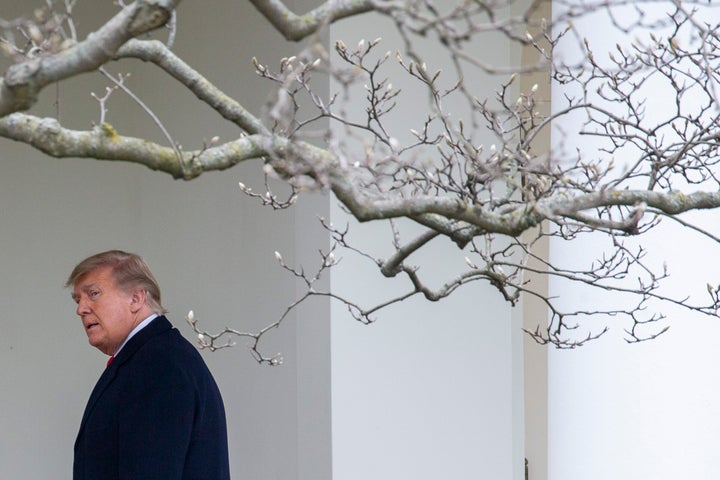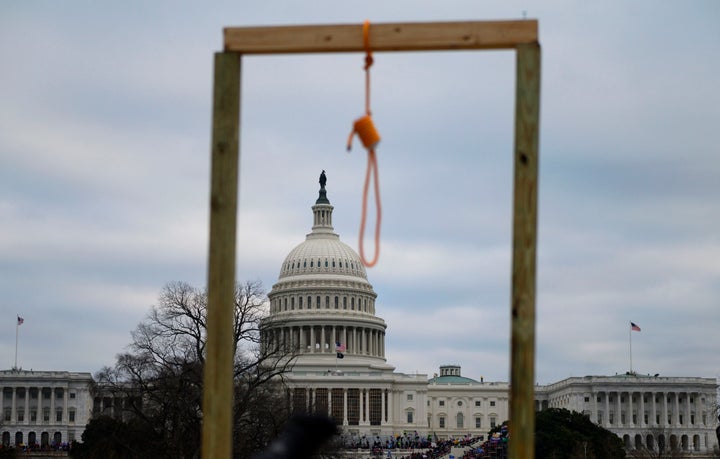Much of the chaos that unfolded on Jan. 6, 2021, happened in full public view: A desperate President Donald Trump, who had already spent weeks spinning lies about the legitimacy of the presidential election, gathered some of his most fervent supporters outside the White House to hear various friends and family members complain about the results before taking the stage himself.
Vice President Mike Pence appeared to have no intention of following Trump’s instruction to disrupt the formal election certification process that day. Still, Trump described his fever dream to the crowd, saying, “All Vice President Pence has to do is send it back to the states to recertify, and we become president, and you are the happiest people.” Trump would be “very disappointed” in Pence if he did not play along. Trump’s supporters, he said, would “never take back our country with weakness.”
“We’re going to try and give our Republicans ― the weak ones, because the strong ones don’t need any of our help ― we’re going to try and give them the kind of pride and boldness that they need to take back our country,” Trump said. He concluded: “So let’s walk down Pennsylvania Avenue.”
Five people died during the melee and its immediate aftermath. Key questions remain about what Trump knew that day, and what he did during those crucial hours when the U.S. Capitol was overrun by his supporters. And beyond the president, not everyone who instigated or participated in the chaos has been held accountable. News reports and congressional investigations over the past year have filled in some of the gaps to help us understand more about the Capitol attack, but there’s still a lot we don’t know.
What was Trump doing all afternoon?
After his speech, Trump was promptly shepherded back to the safety of the White House while his supporters began the 45-minute trek to Capitol Hill on foot. Some had gotten a head start. Thousands of people attacked the Capitol because they believed it was what the president of the United States wanted ― many were heard shouting as much ― all while that president was nowhere to be seen for hours.
The House select committee investigating the attack refers often to a period of 187 minutes between the end of Trump’s speech, at 1:10 p.m., and when he posted a video at 4:17 p.m. politely asking the rioters to go home. (Three other Trump tweets posted in that interval reiterated falsehoods about the election and failed to tell protesters to leave the premises.)
Much of that 187-minute block of time is still shrouded in uncertainty.
The leadership of the congressional committee investigating the events of that day revealed this week that they had firsthand testimony confirming one suspicion: that Trump was watching the riot live on television. As his supporters smashed windows, broke open doors and terrorized police officers, Trump watched from his private dining room off of the Oval Office, according to the committee’s vice chair, Wyoming Rep. Liz Cheney (R).
We know from an extensive, hour-by-hour report from The Washington Post published in October that Keith Kellogg, Pence’s national security adviser, was on hand urging Trump to take action to stop the attack, but that Trump ignored him. He also resisted pleas from his daughter Ivanka, who came into the dining room at least twice, according to Cheney.
Who else did Trump confer with that afternoon? What did they say?

We know that Trump spoke to three people over the phone. One was by accident; Trump intended to call Sen. Tommy Tuberville (R-Ala.), but instead dialed Sen. Mike Lee (R-Utah). Both men were huddled in fear of the rioters Trump had sicced on the Capitol, so Lee had only to pass the phone over to his colleague, who reportedly received an earful from Trump about the need to delay the election certification process. Tuberville hung up in order to evacuate. Trump also talked on the phone to House Minority Leader Kevin McCarthy, who supposedly urged the president to bring a swift end to the riot. When McCarthy argued that the rioters were Trump supporters, not left-wing agitators, the president replied: “Well, Kevin, I guess these people are more upset about the election than you are,” according to Rep. Jaime Herrera Beutler (R-Wash.), who overheard the heated exchange.
But we still don’t know what kinds of conversations Trump had with his chief of staff, Mark Meadows, who avoided the subject in his White House memoir, “The Chief’s Chief,” even though documents released by the Jan. 6 committee indicate he was flooded with messages from people trying to get in touch with Trump at the time. (Meadows is no longer cooperating with the Jan. 6 committee.) Trump may have spoken with Jason Miller, a communications aide; The Washington Post report documented tweets instructing the rioters to go home that Miller allegedly drafted but the president did not send. He may also have spoken with his lawyers. One of them, John Eastman, emailed a Pence aide during the attack to pin the blame on the vice president.
At least one person tried to reach the president through his TV. Chris Christie called into ABC News the afternoon of Jan. 6 with a message: “It’s pretty simple. The president caused this protest to occur. He’s the only one who can make it stop.”
A trove of National Archives records requested by the Jan. 6 committee will likely shine more light on everything Trump did the day of the riot. But at the moment, those documents are tied up in court.
Whom did Trump or his staff talk to outside of the federal government? What did they know?
The Jan. 6 committee revealed this week that members have evidence Trump was speaking to Fox News host Sean Hannity before, during and after the riot. The panel issued a subpoena for the conservative commentator on Tuesday. The committee chairman, Rep. Bennie Thompson (D-Miss.), alleged in a letter that Hannity had expressed “concerns” and provided “advice” to Trump and White House staff about their plans for Jan. 6, and “had relevant communications while the riot was underway.”
The letter also contained text messages Hannity wrote. In one sent the evening of Jan. 5, Hannity wrote that he was “very worried about the next 48 hours.” Given that the certification was set to take place at 1 p.m. the next day ― within 24 hours ― it remains unclear what Hannity might have been worried about, exactly.
Was there any coordination between the White House and the Capitol attack organizers? What was the extent of their plan?
Trump supporters were plotting the events of Jan. 6 weeks and even months before it happened. The signs were right out in the open as well as on more obscure sites; people from across the country were coordinating rides to Washington, D.C., on websites like WildProtest.com and TheDonald.win. They were not shy about calls for violence, either ― BuzzFeed News found “hundreds” of posts discussing bringing firearms to the protest in violation of D.C. gun laws. The day of the riot, law enforcement found guns in cars parked outside the Capitol, and some protesters brought firearms inside.
We know that the White House waged a pressure campaign to get Pence to help overturn the election results, which came to a head on Jan. 6. We know that people inside the White House worked on plans to keep Trump in power using the machinery of the federal government.
What we don’t know is how much White House staff, including Trump himself, knew about the possibility of violence.
While many of the 700-plus people who have been federally charged for participating in the riot appear to have been caught up in the rush of excitement that day, some were also members of organized far-right extremist groups like the Proud Boys and the Oath Keepers. Was there any coordination between those groups and people in Trump’s orbit?
It was a Proud Boy, Dominic Pezzola, who smashed the first window of the Capitol at 2:11 p.m. The first rioters began filtering through the next minute.
A quirk of the building’s defenses have led some to question whether the rioters knew to target certain windows. The vast majority of the Capitol’s 658 single-pane windows were reinforced with bomb-resistant glass during renovations between 2017 and 2019, according a Los Angeles Times report. Only about a dozen were not replaced, for various reasons. Video from the attack shows some of the first rioters to approach the Capitol building made “a beeline” for an area with two unreinforced windows, the Los Angeles Times reported. Did they get lucky? The outlet noted that none of the newly reinforced windows appeared to have shattered ― only the old ones.
Chilling Facebook messages sent to an Oath Keeper who participated in the riot, Thomas Caldwell, also raised questions about the extent of protesters’ planning. According to prosecutors, Caldwell received messages telling him members of Congress were using certain tunnels to flee. “Seal them in,” the message allegedly read. “Turn on the gas.” Court documents did not name the sender.

Who was behind those pipe bombs? What about the noose?
We still don’t know how a pair of pipe bombs ended up on Capitol Hill. On the evening of Jan. 5, an unknown individual wearing a gray hooded sweatshirt, a backpack and black-and-light-grey Nikes with a yellow logo placed the bombs between 7:30 p.m. and 8:30 p.m. near the headquarters of the Democratic National Committee and the Republican National Committee, respectively, the FBI said. But the agency still has no suspects.
Were the explosives supposed to divert law enforcement attention away from the Capitol building?
As Capitol Police Inspector General Michael Bolton testified in May: “If those pipe bombs were intended to be a diversion, it worked.” Several teams of officers left to investigate the bombs after they were discovered on Jan. 6, leaving just a few behind at the Capitol.
Speaking of deadly weapons, we also don’t know who built the scaffold and noose that was photographed outside the building.
Why wasn’t there a better law enforcement response?
Many threats of violence were not taken more seriously because law enforcement believed them to be “aspirational” ― as in, nothing anyone would actually carry out ― and thus protected by the First Amendment right to free speech, according to detailed reporting from The Washington Post. The reason why is not clear.
“This has been one of the most confounding elements of our investigation,” Post reporter Carol Leonnig told NPR’s Terry Gross. “It’s such a mystery to me because the FBI, after 9/11, was deputized with this exact assignment to watch and monitor extremism and interrupt it before it led to a criminal plot,” she said, referring to the FBI’s network of “fusion centers” that are supposed to monitor and share intelligence across agencies. A lot of the planning messages Leonnig came across discussed what seemed to be clearly illegal activity, such as how to smuggle in guns and how to use secure communication methods after breaking into the Capitol.
“I mean, they did not coordinate,” Leonnig said of the agencies.
As a backdrop to the Capitol attack, the weeks leading up to it were some of the most tense of the Trump administration. Justice Department officials ― including people in charge of the FBI and the attorney general’s office ― were on edge wondering whether Trump would fire their leadership and throw their institutions into turmoil out of frustration over having lost the election.
Former Capitol Police Chief Steven Sund attempted to request National Guard help on Jan. 3, but he lacked key information about the extent of the threat and his request was rejected.
Thanks to delays and confusion, around three hours passed between the point when protesters breached the Capitol and when law enforcement began to get a handle on the situation. Officials had recognized the need for National Guard assistance within the first 10 minutes; at 2:22 p.m., D.C. Mayor Muriel Bowser requested help from the National Guard on a call with Army Secretary Ryan McCarthy and other law enforcement officials, according to an official record. But the request was not immediately approved by acting Defense Secretary Christopher Miller. Law enforcement finally finished their sweep of the Capitol around 8 p.m.
The Washington Post’s investigation underscored previous reports that some top military leaders were concerned about the optics of having the National Guard on hand to block a political protest. Some were concerned that Trump might try to use the National Guard for his own ends.
Military leaders have so far given conflicting accounts of the delay. The Jan. 6 committee will likely provide more concrete and substantial answers in a final report.
What else did Trump do ― or try to do ― to prevent Joe Biden from becoming the duly elected president of the United States?
There was also a legal insurrection underway leading up to Jan. 6, and it was just as dangerous to democracy, if not as visible. We know Trump pressured local election officials in at least one state ― Georgia ― to “find” enough votes to tip the scales of the election. We know someone under his thumb, former Attorney General William Barr, issued an unusual memo to authorize voter fraud investigations before the results were certified. We know Trump tried to convince Barr’s replacement, acting attorney general Jeffrey Rosen, to meddle with the election results over baseless claims of voter fraud.
Was there anything else we don’t know about?
Since Trump’s 2020 loss, Republicans have been working in plain view to stack the deck in their favor. Ahead of future elections, they’ve begun to implement changes to how elections proceed in key swing states around the nation, giving partisan officials more control over elections and making it harder to vote to begin with. They’ve demanded audits that help cast doubt in voters’ minds about the legitimacy of the democratic process.
In the aftermath of Jan. 6, perhaps the biggest unanswered question is just what we can expect in future American elections.

